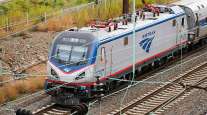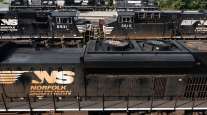Amtrak Anti-Crash System May Malfunction Near Freight Rails

Radio interference from freight railroads may disable the automated solution Amtrak is finalizing to prevent high-speed derailments like last month’s fatal accident in Philadelphia.
The system that commands trains to slow to avert crashes may not work properly in some locations in the U.S. Northeast because it relies on airwaves that can be blocked by signals from equipment on adjacent freight tracks, according to the Federal Communications Commission.
Freight railroads operating from New Haven, Connecticut, to Boston plan to use the same radio frequencies as Amtrak for their separate train-safety system, Charles Mathias, associate chief of FCC’s Wireless Telecommunications Bureau, told Congress on June 10.
“This could degrade or disable communications on both systems, causing either or both to function improperly or stop functioning altogether,” Mathias said at a hearing of the Senate Commerce, Science and Transportation Committee in Washington. “We understand the criticality of this,” and FCC is working with railroads to resolve the issue, he said.
The radio-interference issue creates a new hurdle for the system that the National Transportation Safety Board said would have prevented the May 12 derailment in Philadelphia that killed eight passengers and injured hundreds. Known as positive train control, it has been delayed for years while railroads attempted to buy airwaves and wrestled with cost and technical issues.
Amtrak has options to resolve the interference and expects to complete installation by the end of the year on rails it owns along its popular Northeast Corridor route that snakes from Washington to Boston, spokeswoman Christina Leeds said in an e-mail. The passenger rail service has spent $110.7 million on the control program since 2008, Leeds said.
Installation was slowed because it took five years to purchase access to radio frequencies, DJ Stadtler, Amtrak’s vice president of operations, told the committee. He said Amtrak didn’t receive permission until May 29 to begin testing the system south of New York.
While Amtrak has sorted out those issues, it must consider the possibility that the system won’t operate as planned once freight railroads install their train-control technologies.
Because freight railroads aren’t ready to complete their system immediately, interference issues shouldn’t prevent Amtrak’s from working at least initially, Stadtler said.
Senate Commerce Committee Chairman John Thune (R-S.D.) said most railroads won’t finish installing the system by Dec. 31, and Congress needs to set a “thoughtful” revised schedule.
While the train-control system has been in the works for years, it was thrust back into the spotlight last month after an Amtrak train going through Philadelphia sped toward a curve at as much as 106 mph, or more than twice the limit, and derailed.
Investigators still are searching for answers to why the train was far exceeding the speed limit and why the engineer didn’t apply the emergency brakes sooner than he did.
In a report released just before the June 10 hearing, NTSB said there was no evidence so far to show that engineer Brian Bostian was on his mobile phone or that he violated Amtrak policy prohibiting distractions from calls and texts.
He also didn’t access the train’s Wi-Fi system while operating the locomotive, NTSB said.
“We have determined that there was no talking or texting or data use involved,” NTSB Vice Chairwoman T. Bella Dinh-Zarr told the Senate committee.
Investigators haven’t ruled out whether the phone may have been used in other ways, Dinh-Zarr said.
NTSB is attempting to determine whether the device was in “airplane mode” or was switched off during the trip. They have been examining the phone’s operating system, which contains more than 400,000 files, according to NTSB’s statement.
Bostian, who suffered a head injury, has told investigators he doesn’t recall what happened prior to the crash. Bostian gave investigators his phone’s password, which allowed them to access data on the device without having to seek a subpoena, according to NTSB.
The investigation will continue into the crash, which Amtrak estimates cost more than $9.2 million, according to a preliminary NTSB report released June 2.




